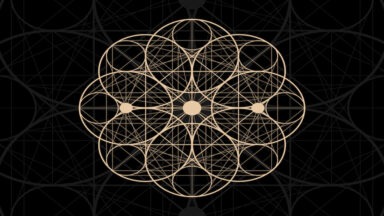Ancient Symbols of Protection from Cultures Around the World
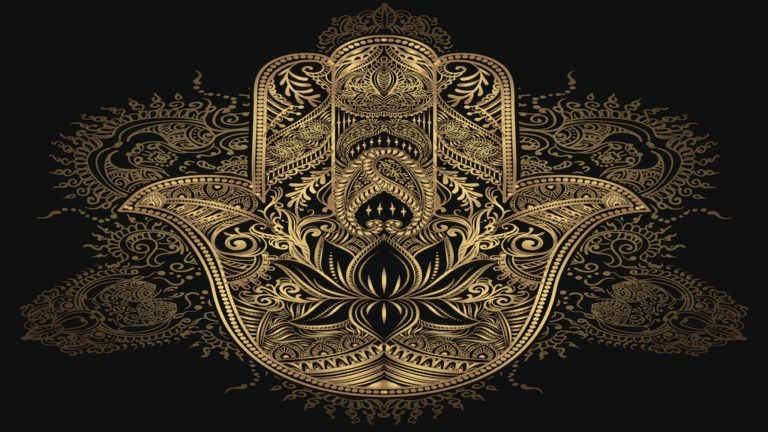
Throughout human history, people have searched for ways to safeguard themselves from negative energy, evil spirits, and other forces beyond their control. Across different cultures, ancient symbols of protection emerged to provide guidance, comfort, and spiritual protection. These protection symbols often reflect humanity’s close relationship with nature, the divine, and the mysteries of existence. They have appeared across continents, in various belief systems—from the ancient Egyptians, Greeks, and Celts to Native Americans, Vikings, Pagans, Christians, Jews, and Muslims. Each carries its own story and context, offering not only a symbol of protection against evil forces but also a source of good fortune, positive energy, and well-being in daily life.
If you feel drawn to these powerful protection symbols, it can be overwhelming to understand their origins and meanings. By exploring their cultural contexts and historical significance, you can discover which ancient protection symbols resonate most with you, whether you seek a protective amulet, a talisman, or a sacred sigil to incorporate into your spiritual practice.
Native American Protection Symbols
Native American tribes traditionally embraced ancient symbols of spiritual protection connected to the natural world. Animal totems, for example, represent protective powers derived from the wearer’s guardian spirit. Some of the most common animal symbols include:
- Bear: Represents leadership, physical strength, courage, and the ability to face challenges head-on.
- Crow: Embodies wisdom, intelligence, and keen awareness.
- Eagle: A revered bird symbolizing courage, wisdom, and strength; it also connects the earthly realm to the divine.
- Deer: Offers guidance to safety, gentleness, prosperity, and shelter.
- Gila Monster: Portrays preservation, resilience, and survival.
- Dragonfly: A sign of happiness, speed, and purity, often seen as a symbol of positive transformation.
- Lightning (Thunderbird): Associated with a legendary spirit of power, rain, and renewal.
In addition to animal totems, other Native American symbols provide spiritual protection:
- Arrows: These can signify defense, direction, and the warding off of evil spirits. An arrow pointing to the left often signals protection, while a downward-facing arrow can represent peace. Arrowheads carry protective properties, symbolizing alertness and focus.
- Cacti: Embody warmth, endurance, and maternal love, persisting even in harsh conditions.
- Drums: Used in sacred ceremonies to communicate with the Great Spirit, invoking divine protection.
- Eagle Feathers: Central to rituals and prayer, representing truth and spiritual activation.
- Medicine Bags: Typically made of animal hide and containing items like sage, tobacco, minerals, or a pipe, these bags were believed in ancient times to offer divine protection and good luck, especially in battle.
Ancient Egyptian, Celtic, Christian, and Greek Protection Symbols
Ancient Egypt, Greece, Celtic lands, and early Christian societies also developed significant ancient protection symbols. Within these various cultures, certain motifs recur, bridging continents and belief systems:
- The Cross: While often associated with the Christian faith, the cross also appears in many contexts. The ancient Egyptian symbol known as the ankh signifies eternal life and spiritual reflection. In Greek traditions, a cross represents the four directions and natural balance, much like in Native American symbolism.
- Eyes: In Egyptian culture, the Eye of Horus—an ancient Egyptian symbol resembling the right eye of the falcon god Horus—represents healing, protection, and the harmonizing of masculine and feminine energies. Similarly, the Eye of Ra symbolizes cosmic order and the sun’s protective force. Across cultures, the eye often appears as a symbol of protection—for example, the evil eye, a belief found in the Middle East, the Mediterranean, and beyond. Depictions like the nazar (a blue-eye-shaped amulet) are used to ward off evil forces and bad luck.
- The Hamsa Hand: Originating in the Middle East, North Africa, and regions influenced by Islamic and Jewish mysticism, as well as some Christian sects, the Hamsa hand is a protective amulet. Often used to repel the evil eye, it symbolizes divine guardianship, good fortune, and spiritual resilience. The Hamsa appears prominently in Arabic, Hebrew, and ancient Egyptian contexts, making it a potent emblem of spiritual protection.
- Wreaths: In early Christianity, wreaths represented eternity and the unending circle of life. Some believe displaying a wreath invites the spirit of Christ into the home. In Ancient Rome, wreaths were hung on doors after victorious battles. Today, wreaths can symbolize resilience, continuous growth, and persistent life force amid adversity.
Pagan, Wiccan, Norse, and Occult Protection Symbols
Beyond religious traditions, protection symbols from around the world appear in Pagan, Wiccan, Celtic, and Norse cultures. These symbols often focus on nature, cosmic cycles, and positive energy:
- Labyrinths (Wiccan/Pagan): Walking a labyrinth is a spiritual journey symbolizing wholeness, renewal, and guidance. One cannot get lost in a labyrinth, reflecting the soul’s steady path through life’s challenges.
- Yggdrasil (Norse): This great Viking tree of life connects all realms, symbolizing stability, wisdom, and cosmic order. It serves as an anchor of spiritual protection and unity.
- Powerful Protection Symbols in Norse Traditions:
- The Helm of Awe: A famed Viking symbol for protection, this Icelandic protection symbol (or Icelandic sigil) consists of eight rune-like arms radiating from a center point. It’s believed to protect the wearer from harm and instill fear in enemies.
- Thor’s Hammer (Mjölnir): Another Norse emblem, representing strength, courage, and the safeguarding of humanity. Mjölnir often symbolizes good luck in battles and marriages, as well as blessings for new ventures.
- Wiccan Protection Symbols:
- The Pentagram (Pentacle or Five-Pointed Star): Revered in Wicca, this shape can ward off evil spirits and negative influences. It often reflects the balance of earth, air, fire, water, and spirit.
- Mistletoe: Rooted in Celtic tradition, mistletoe is considered a protector against evil forces, ensuring good luck and prosperity for the community, livestock, and children.
- Runes and Other Amulets: Runes, ancient alphabetic symbols used by Viking and Germanic tribes, can serve as talismans, focusing positive energy and offering guidance. In many belief systems, wearing certain runes or sigils helps ward off negative energies and attract good fortune.
Chinese Symbols of Protection
In Chinese culture, powerful creatures and geometric forms serve as key symbols of protection. These symbols not only guard against negative energy but also foster balance, harmony, and spiritual integrity within the environment and the individual’s life.
- The Dragon: Considered a divine, mythical beast, the dragon symbolizes good fortune, wisdom, and protective energy. It is often depicted guarding temples, homes, and even imperial palaces. The dragon’s presence is thought to ensure well-being, ward off evil spirits, and attract positive influences.
- The Phoenix: Revered as the queen of birds, the phoenix represents renewal, grace, and the harmonious interplay of yin and yang energies. In Chinese lore, when the phoenix appears, it heralds peace, prosperity, and a protective atmosphere—creating a shield against misfortune and bringing forth positive energy.
- The Hexagram: Known in many cultures, the six-pointed star shape is commonly recognized as the Star of David in Jewish tradition. However, variations of this symbol appear in Chinese spiritual practices as well. As a geometric form that balances opposing forces, the hexagram is believed to stabilize energy fields, offering divine protection and spiritual equilibrium.
Islamic and Other Cultural Variations
Beyond Chinese traditions, similar protective symbols are woven into Islamic art and sacred geometry, as well as in the faiths and folk practices of numerous other cultures. Intricate calligraphy, symmetrical patterns, and sigils serve as spiritual safeguards, reflecting the idea that harmony and order can repel chaos and negativity.
Across continents—from the Middle East and the Americas to Africa and Europe—these protective emblems underscore a common theme: the universal human desire for safety, hope, and a sense of connection to something greater. Whether channeled through mythical creatures, geometric patterns, or sacred calligraphy, the worldwide prevalence of these powerful protection symbols highlights the shared spiritual heritage that continues to guide and uplift us today.
Embracing Protection Symbols in Modern Times
From ancient times to modern spiritual practices, humanity’s desire for spiritual protection and divine protection remains. Whether you choose to wear an amulet, display a protective talisman, meditate upon sacred symbols under a full moon, or incorporate an ancient Egyptian symbol like the Eye of Horus into your spiritual routine, these symbols continue to guide and comfort us. They connect us to ancestral wisdom, helping us navigate life’s uncertainties with renewed confidence and trust in higher powers.
In essence, these ancient symbols of protection not only guard against negative energy but also remind us of our shared humanity. Through their activation in our lives, we embrace cultural diversity, historical depth, and the reassurance that we are never truly alone. As we honor these timeless emblems and integrate their meanings into our personal journeys, we open ourselves to their healing presence and good fortune, finding comfort in a world filled with countless unseen mysteries.
In addition to spirit animals, Native American tribes believe in other symbols of protection such as:
— Arrows – symbolize defense and protection. An arrow pointing to the left keeps away evil; an arrow pointing to the right also represents protection; an arrow facing downward represents peace. Arrowheads signify alertness and direction.
— Cacti – are the embodiment of warmth, protection, and endurance, as well as maternal love that endures regardless of harsh conditions and circumstances
— Drums – a central part of all Native American ceremonies, are the means to communicate with the Great Spirit.
— Eagle feathers – used during sacred rituals and prayer, represent the truth.

— Medicine bags – usually made out of animal hide, contains items such as a pipe, minerals, tobacco, sage, and other protective items. In ancient times, medicine bags were thought to have the power to protect in times of battle and war.
Egyptian, Celtic, Christian and Greek Symbols of Protection
Not only the protective realm of the Native American culture, ancient Celts also have a deep belief in animal spirits, from the bull, the sign of wealth, status, and fertility, to the salmon, which symbolizes wisdom and the sanctity of life.
While cultures have their unique protective symbols, there are some which reach across traditions, such as the cross, wreaths, hands, and eyes.
— Cross: Usually associated with Christianity and the crucifixion of Jesus Christ, and a sign of benediction, the cross also has significance in other cultures. The ancient Egyptian ankh is the representation of life, with the rounded top symbolizing a mirror of self-reflection. The Greek cross represents the four directions of the earth, as does the cross in Native American Cultures.
— Eyes are an important protective symbol in ancient Egyptian culture. The Eye of Horus, resembling the right eye of the falcon God Horus, and the Eye of Ra, or the Sun God, represent the universe, masculine/femine energies, and the sun and moon. The Eye of Horus is considered protective and healing and the eye as a universal protective symbol is also seen in the Masonic eye, as well as in the modern pharmaceutical symbol.
— Believed to ward off the “evil eye,” the protective symbol of the hand, or hamsa, is worn around the neck, or hung on the walls. Hamsas can be traced to the Middle East with roots in Arabic, Hebrew, and North African cultures, as well as in ancient Egypt and some Christian sects.
— Wreaths harken back to early Christianity, from the choice of the kind of branches, to the shape itself. When a wreath is displayed on a door, the symbol stands as an invitation for the spirit of Christ to enter the home. Others associate the wreath with Ancient Rome, which was hung on doors after a victorious battle. For most people, wreaths are a symbol of the circle of life, as well as the evergreen, which represents resiliency through harsh conditions.
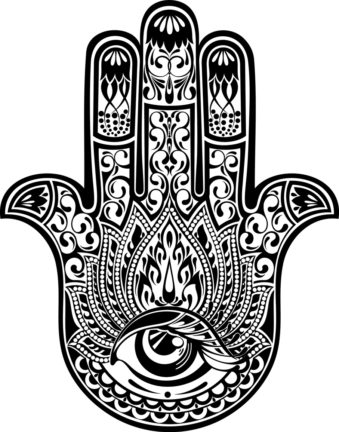
Hamsa hand, protection amulet, symbol of strength
Beyond Religion: Protective Symbols in Pagan and Occult Cultures
In addition to the protective symbols religious associations, they also stand at the center of many Pagan, Wiccan, and occult beliefs The Wiccan practice of walking labyrinths signifies the full life cycle, as well as a protective path as one cannot get lost in a labyrinth; there is always a way in and a way out. For the Norse tradition, Yggdrasil, the tree of life, is a protective representation of a universal and central connection. Other pagan and pre-Christian symbols include:
- Viking symbols of protection such as the Helm of Awe, whose eight-pronged trident protects against hostile forces, and Thor’s Hammer, the symbol of protection of humans, as well as blessings for marriages.
- Wicca — The pentagram, a five-pointed star is thought to ward off witches and demons, while elevating spirit over matter.
- Mistletoe, while normally thought of as a cute Christmas decoration, it has deep Celtic roots and is considered to be a protective symbol for everything from love, to livestock, and babies.
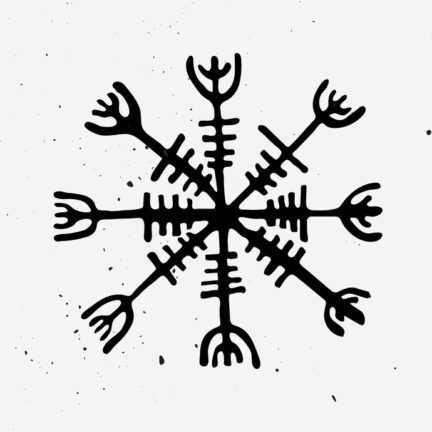
Norse Symbol: The Helm of Awe
Protective symbols can also be viewed as stemming from the desire for a more expansive relationship to all the universe has to offer — from the good, to the dark, to the in-between. The importance that protective symbols in ancient and modern cultures have in our lives could be seen as a level of humility toward powers larger than us. When life gets complicated and challenging, accessing our shared protective symbols can serve as the ultimate spiritual lighthouse, helping to guide us through life’s uncertain waters.
These Near-Death Experiences Describe Direct Experiences With God
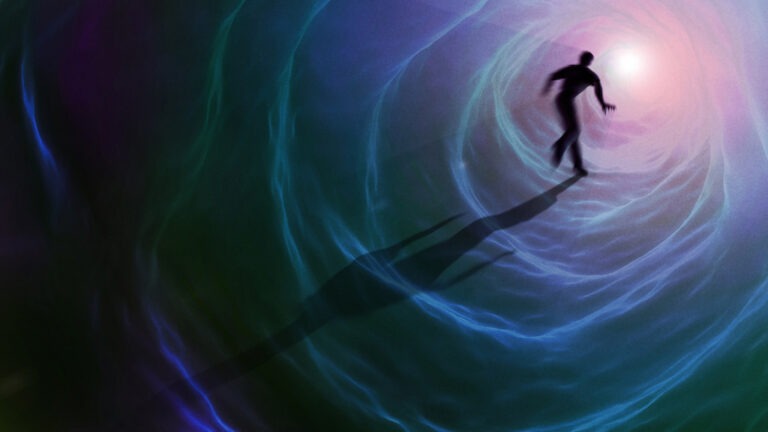
What do near-death experiences suggest about the ultimate source of reality, spirituality, and what many call “God?” Psychiatrist Raymond Moody explains the answer to this question in his latest book “God Is Bigger Than the Bible.”
Dr. Raymond Moody has spent more than four decades studying the afterlife. In his 1975 book “Life After Life” he first presented his research on the “near-death experience” or NDE, the transcendent experience of death that radically transforms the life of the person who lives to tell about it. In his new book, Dr. Moody presents his thoughts on God, drawn from the accounts of the thousands of people he has interviewed about their near-death experiences.
“You know, when I was a kid I didn’t think about God. I can’t say I was an atheist because I never really thought about God,” Dr. Moody said. “Then I went to college and got interested in these near-death experiences through Plato, and subsequently have heard of thousands of these from people all over the world who have this same kind of experience—many of them have conversations with God. So that is how I came to God, you know God has become just a big part of my life in the last few decades.”
Dr. Moody’s motivation for writing his latest book is to provide readers with an understanding of God, or source, that is entirely outside the realm of organized religion. To Dr. Moody, idealized religion can present a fearsome image of God that has scared many away from developing a personal relationship with the divine.
“Well, before I started hearing of people with near-death experiences, my notion of God was that people had this imaginary figure who was watching their every step with a little book, trying to see if they’re going to stumble or something,” Dr. Moody said. “But when I started hearing these people with near-death experiences it was a whole different take on God. People say that when they had their cardiac arrest or whatever, that they left their bodies and dissolved into this light, almost. People say that whatever kind of love that you have experienced while you’re alive, that is just beyond description. You go through a passageway to this light of complete comfort, peace, and love, you feel sort of wrapped up in it.”
A common component of the NDE is what is known as the “life review.”
“People say they’re surrounded by a holographic panorama consisting of everything they’ve ever done, and they witness it from the point of view of the other people they’ve interacted with. And all of this is being experienced in the presence of a being of complete compassion and love, who sees all those things they’ve done there, but there’s no judgment coming from this—that this being is helping you evaluate these things. They say that there are no words but that the thought comes through. The question that comes from this being is ‘how have you learned to love?’ People learn a lot about themselves from these encounters with God,” Dr. Moody said.
Through his research, both with near-death experiencers and the elderly, Dr. Moody has come to an understanding of God as the writer of our life stories.
























